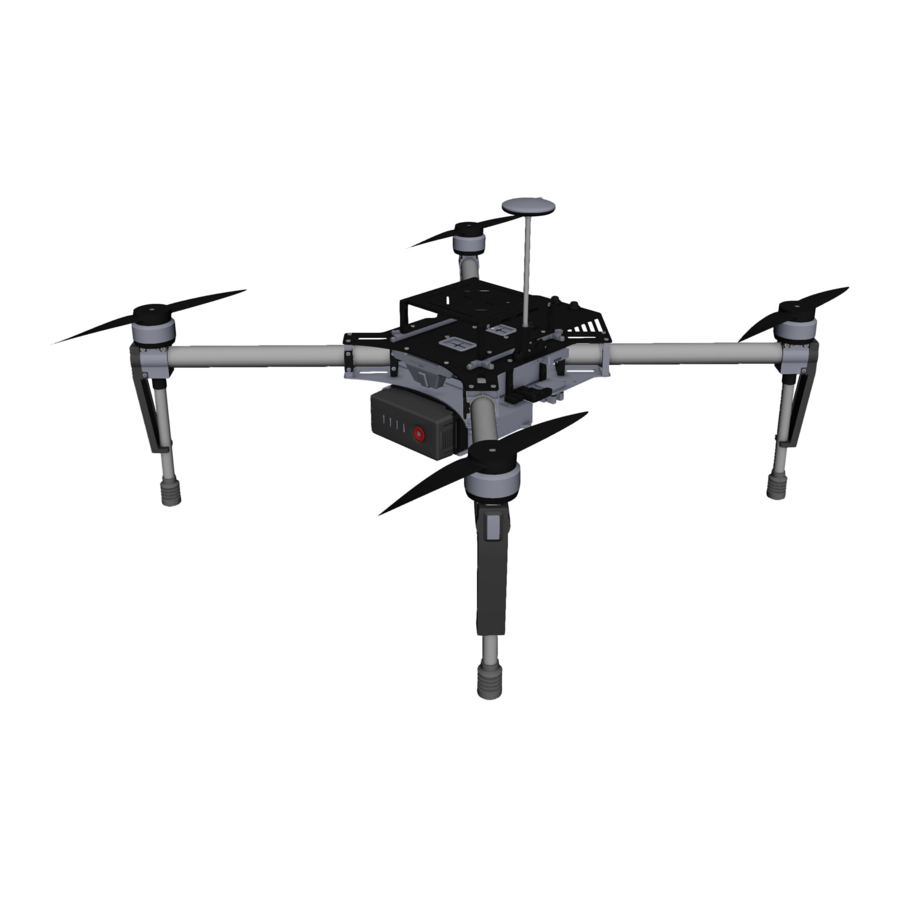dji Matrice 100 Instruções de segurança - Página 3
Procurar online ou descarregar pdf Instruções de segurança para Quadricópteros dji Matrice 100. dji Matrice 100 4 páginas. Intelligent flight battery
Também para dji Matrice 100: Manual de Segurança (20 páginas), Manual rápido (2 páginas)

8) Electrolytes in the battery are highly corrosive. If any electrolytes make contact with your skin or
eyes, immediately wash the affected area with fresh running water for at least 15 minutes, and
then see a doctor immediately.
9) Do NOT use the battery if it was involved in a crash or heavy impact.
10) If the battery falls into water with the aircraft during flight, take it out immediately and put it in a
safe and open area. Maintain a safe distance from the battery until it is completely dry. Never use
the battery again, and dispose of the battery properly as described in the Battery Disposal section
below. Do NOT heat batteries. Put out any battery fire using sand or a dry powder fire extinguisher.
11) Do NOT put batteries in a microwave oven or in a pressurized container.
12) Do NOT place loose battery cells on any conductive surface, such as a metal table.
13) Do NOT put the loose cells in a pocket, bag or drawer where they may short-circuit against other
items or where the battery terminals could be pressed against each other.
14) Do NOT drop or strike batteries. Do NOT place heavy objects on the batteries or charger. Avoid
dropping batteries.
15) Clean battery terminals with a clean, dry cloth. When the terminals are dirty, unintended energy
consumption or an inability to charge the battery may result.
Battery Charging
1) Do NOT attach the batteries to wall outlets or car charger sockets directly, and always use a DJI
approved adapter. DJI takes no responsibility if the battery is charged using a non-DJI charger.
2) Never leave the battery unattended during charging. Do NOT charge the battery near flammable
materials or on flammable surfaces such as carpet or wood.
3) Do NOT charge battery immediately after flight, because the battery temperature may be too high.
Do NOT charge the battery until it cools down to near room temperature. Charging the battery
outside of the temperature range of 0℃-40℃ may lead to leakage, overheating, or battery damage.
4) Charge and discharge the battery completely once every 10 charge/discharge cycles. Discharge
the battery until there is less than 5% power or until it can no longer be turned on, then recharge
it to the maximum capacity. This power cycling procedure will optimize the battery life and help
calibrate the battery gauge.
5) Disconnect the charger when not in use. Examine the charger regularly for damage to the
cord, plug, enclosure, or other parts. Do NOT clean the charger with denatured alcohol or other
flammable solvents. Never use a damaged charger.
6) Never transport a damaged battery or a battery with power level higher than 50%.
Battery Storage
1) Keep batteries out of the reach of children and pets.
2) Do NOT leave the battery near heat sources such as a furnace or heater. Do NOT leave the
batteries inside of a vehicle on hot days. The ideal storage temperature is 22℃-28℃.
3) Keep the battery dry. Never drop the battery into water.
4) Do NOT drop, strike, impale, or manually short-circuit the battery.
5) Keep the battery away from metal objects such as glasses, watches, jewelry, and hairpins.
Battery Disposal
1) Dispose of the battery in specific recycling boxes only after a complete discharge. Do NOT place
the battery in regular trash containers. Strictly follow your local regulations regarding the disposal
and recycling of batteries.
Battery Maintenance
1) Never use the battery when the temperature is too high or too low.
2) Never store the battery in environments with a temperature higher than 60℃.
Travel Notice
1) Before carrying the Intelligent Flight Battery on an airline flight, it must first be fully discharged.
This can be done by using your aircraft until the battery is depleted. Only discharge the battery in
a fireproof location.
©
2015 DJI. All Rights Reserved.
2
